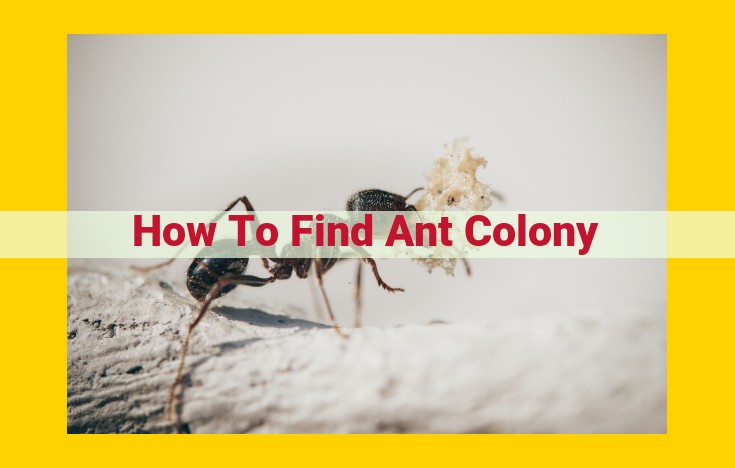To locate an ant colony, observe their behavior and environment. Ants are active during warmer hours, search for trails of ants that lead to and from food sources or a nesting site. Check areas with moisture, such as under logs, rocks, or bricks, or near food sources. Ant colonies usually have a central entrance and exit, and ants may be seen carrying food or debris back and forth. Be cautious when approaching a colony, as some species can be aggressive.
Ant Colony Biology and Behavior: A Fascinating Insight into Nature’s Microscopic Marvels
Ant colonies are complex and fascinating societies, teeming with life and intricate behaviors. The social organization and communication mechanisms of these tiny creatures are a testament to the wonders of the natural world.
Caste System: The Foundation of Ant Society
Ant colonies consist of a diverse array of individuals, each fulfilling a specific role within the colony. Queens, the largest ants, are responsible for egg-laying, ensuring the colony’s survival. Workers, on the other hand, are smaller and perform a wide range of tasks, including foraging for food, constructing and repairing the nest, and caring for larvae. Soldiers are the colony’s defenders, possessing large mandibles and aggressive behavior to protect their home from threats.
Communication Through Pheromones
Ants rely on chemical signals called pheromones to communicate with each other and navigate their environment. These pheromones are produced by specialized glands and can convey a variety of messages, such as alerting to food sources, marking trails, and even triggering defensive responses. Ants leave a trail of pheromones as they move, guiding other ants to valuable resources and coordinating colony activities.
Defense Mechanisms: Protecting the Colony
Ant colonies employ various mechanisms to protect themselves from predators and maintain their stability. They may use aggressive behavior to repel intruders, secrete defensive chemicals, or even construct intricate tunnels and chambers to shield themselves from harsh conditions. Additionally, ants often form symbiotic relationships with other species, such as aphids, providing protection in exchange for food.
Ant Colony Observation and Study
Understanding the intricate world of ant colonies requires detailed observation and scientific investigation. Field observation provides valuable insights into their natural behaviors, while scientific research methods enable researchers to unravel the underlying mechanisms of ant society.
Field Observation and Data Collection
Observing ant colonies in their natural habitat requires patience and specialized equipment. Ant nests provide a convenient focal point for observation, allowing researchers to study the colony’s structure and activities. Magnifying glasses and binoculars enhance the observer’s ability to discern individual ants, their roles, and their interactions.
Data collection is crucial for documenting observations. Notebooks, audio recordings, and digital photography are essential tools for capturing details such as ant numbers, caste distribution, and foraging patterns. By carefully recording these observations, researchers can build a comprehensive picture of the colony’s behavior.
Scientific Research Methods
Scientific methods provide a systematic approach to studying ant colonies. Taxonomic identification establishes the species composition of the colony, allowing researchers to compare behaviors across different ant taxa. Behavioral assays involve controlled experiments to examine specific ant behaviors, such as pheromone trail following, resource allocation, and social interactions.
Molecular techniques play an increasingly significant role in ant research. DNA analysis reveals genetic diversity within colonies and helps identify species that may be difficult to distinguish based on morphology alone. Transect surveys and population modeling provide insights into colony growth, distribution, and the impact of environmental factors.
Understanding ant colonies is a complex and fascinating pursuit that combines the art of observation with the rigor of scientific investigation. Through these methods, researchers continue to unravel the secrets of these remarkable insects and their essential role in our ecosystems.
Ant Colony Benefits and Challenges
In the intricate tapestry of nature, ants play an indispensable role as ecosystem engineers. Their bustling colonies provide a myriad of benefits to the environment, while facing unique challenges that require our attention.
Ecological Blessings
Ants are nature’s tireless sanitation workers, voraciously devouring insect pests, including disease-carrying mosquitoes. Their subterranean tunneling and foraging create aerated soil, enhancing drainage and fostering plant growth. Moreover, ants are crucial seed dispersers, contributing to the reproduction and diversity of plant species.
Threats to Ant Colonies
Like all organisms, ant colonies face their own set of trials. The indiscriminate use of pesticides poses a significant threat, as these chemicals can disrupt communication and kill ants outright. Additionally, habitat loss due to urbanization and deforestation fragments and isolates colonies. Invasive species, such as the Argentine ant, can also displace native ant species, upsetting ecological balance.
Preserving Our Ant Allies
Recognizing the importance of ants in our ecosystems, conservation efforts are essential. Limiting pesticide use and promoting organic farming practices safeguard ant colonies. Protecting and restoring natural habitats provides them with refuge. Furthermore, raising awareness about the vital role ants play fosters appreciation and encourages responsible stewardship.
Managing Ant Invasions
While ants are beneficial, their presence in homes can sometimes be unwelcome. To manage ant infestations, bait traps and exclusion barriers can be employed. Bait traps utilize food attractants to lure ants, allowing for targeted elimination. Exclusion barriers, such as caulk and weatherstripping, seal entry points, preventing ants from entering in the first place.
